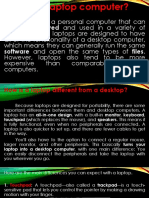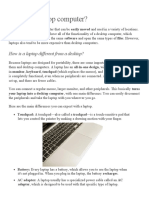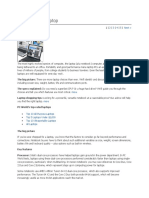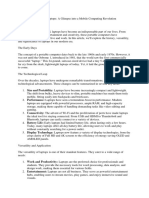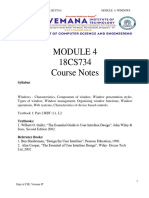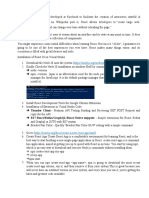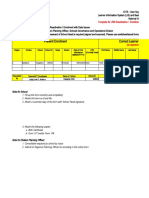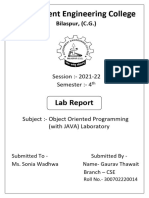A laptop is a portable computer with a clamshell design, integrating a screen, keyboard, touchpad, and all
other components into a single, compact unit. Unlike a desktop computer, a laptop includes a rechargeable
battery for on-the-go use.
Core Components
A laptop is made up of several key components that work together to function.
CPU (Central Processing Unit) 🧠: The "brain" of the laptop, the CPU processes all instructions and
calculations. Popular brands include Intel Core (i3, i5, i7, i9) and AMD Ryzen (3, 5, 7, 9).
RAM (Random Access Memory) ⚡: This is the laptop's short-term memory, holding data for quick
access. More RAM allows for smoother multitasking. Most laptops today have at least 8GB of RAM,
with 16GB or more being common for demanding tasks.
Storage : This is where all your files, programs, and the operating system are permanently stored.
Laptops use either a faster SSD (Solid State Drive) or a traditional, slower HDD (Hard Disk Drive).
Many modern laptops use SSDs for speed.
GPU (Graphics Processing Unit) : The GPU is responsible for rendering images and video on the
screen. Basic laptops use integrated graphics (part of the CPU), while gaming or professional laptops
have a more powerful dedicated GPU (e.g., NVIDIA GeForce or AMD Radeon).
Motherboard : The main circuit board that connects all the components and allows them to
communicate with each other.
Display 💻: The screen. Laptops come with various display technologies, including LCD, LED, and the
more vibrant OLED, which offers superior contrast and color. Screen sizes and resolutions vary.
Battery 🔋: The rechargeable power source that allows for portability. Battery life is a critical factor
and varies based on usage, hardware, and screen brightness.
Cooling System ❄️: Systems like fans and heat pipes that prevent components from overheating,
which is especially important in powerful, thin laptops.
Types of Laptops
Laptops are categorized by their design and intended use:
Traditional Laptop / Notebook: The standard clamshell design, suitable for everyday tasks like web
browsing, document creation, and media consumption.
Ultrabook: A marketing term for thin and lightweight laptops that offer high performance and long
battery life. They're ideal for students and professionals who need portability.
2-in-1 Laptop: These laptops can function as both a traditional laptop and a tablet. They typically
have a touchscreen and a hinge that allows the screen to fold 360 degrees or a detachable
keyboard.
� Gaming Laptop: Designed for high-performance gaming, these laptops have powerful CPUs,
dedicated GPUs, and advanced cooling systems. They are often heavier and more expensive than
other types.
Chromebook: A low-cost, lightweight laptop that runs on Google's Chrome OS. It's designed
primarily for cloud-based tasks and is a good option for basic productivity and web use.
Operating Systems
A laptop's operating system (OS) is the software that manages its hardware and software resources,
providing the user interface. The most common OS types for laptops are:
Microsoft Windows: The most widely used operating system globally, known for its versatility and
vast software compatibility.
macOS: The proprietary OS for Apple's Mac computers, known for its user-friendly interface and
strong integration with the Apple ecosystem.
Linux: A free, open-source OS with many different versions (called distributions). It's popular with
developers and power users due to its customization and security.
Chrome OS: A lightweight OS from Google that focuses on web applications and cloud storage.
What are the pros and cons of SSD vs HDD?What are the key factors to consider when buying a laptop?How
do I maintain my laptop's battery life?










